
 |
|
|
|
The "New Hollywood" careers of Bob Rafelson, Bert Schneider and Steve Blauner are now synonymous with the new freedom of the late '60s and '70s, a period that many insist was the most artistic for American movies. That last notion continues to be debated. The chapters devoted to the rise and fall of the trio's BBS company in Peter Biskind's 1998 book Easy Riders, Raging Bulls delight in charting the excesses of the company's founders, while still finding their work more adventurous than the output of some of the '70s crop of student film wunderkinds, the Spielbergs et al.. Criterion's ambitious Blu-ray boxed set America Lost and Found the BBS Story gathers seven features germane to the discussion. It's true: all represent alternatives to Hollywood factory product. Three or four can also be classified as popular hits. Interestingly, Criterion took over the Lost and Found disc project, which had already been completed at Sony, presumably as a DVD release. Some of the extras were produced by Sony two years ago. BBS occupied a multi-story office building on La Brea Avenue for most of the 1970s, after which the space was taken over by, of all people, Redd Foxx. The building had a cozy atmosphere and a laid-back quality; one friend worked there and another maintained the 16mm rental library for the company's non-theatrical offshoot, RBC. I remember that RBC had the license for Charlie Chaplin's movies, and they rented like hotcakes. 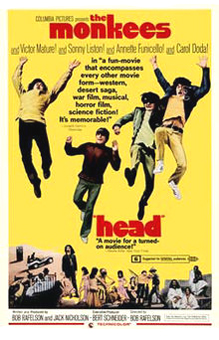
As the Raybert Company, Rafelson and Schneider began not as film students but as shrewd TV packagers. They created The Monkees, a pop group manufactured to be just like The Beatles, only more accessible (and marketable, and controllable). The successful TV show made the partners a fortune and encouraged them to branch out into film work. Just as the group were breaking up, Bob Rafelson directed Head, an attempt to use the Monkees phenomenon to deconstruct the culture. The writer was Jack Nicholson, who had spent the 1960s busy but treading water as an actor while working his way into more active creative roles in Roger Corman films. A free-form collage of styles and visual gimmicks, Head is purposely nonsensical, and self-reflexive; almost every "scene" is revealed to be a filmic illusion. The four Monkees critique their status as rebels struggling in a commercial strait-jacket, while the film lampoons old Hollywood movies, chosen political targets and The Establishment in general. Defenders are quick to remind us that Head may be the first studio release to openly diss the war in Vietnam. A "fun musical romp for the kids", it also uses a repetition of the famous, gruesome newsreel shot of a South Vietnamese security officer murdering a suspected Viet Cong with a pistol shot to the head. It's as if a bit of the French May Strike had leaked into the wacky world of the Monkees. 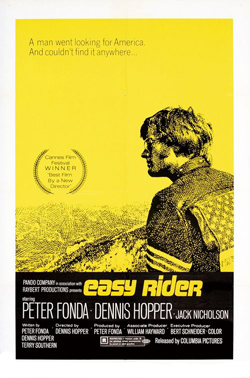
Head came out in September of 1968 and didn't attract much attention. But Raybert already had Dennis Hopper's Easy Rider on the launching pad; it only remained for the company to kick Hopper out of the cutting room and get a finished cut out the door. A genuine loose cannon in a film game that required at least a minimum of reliability, Hopper made his tale of drug dealers looking for America at Raybert only after being turned down by American-International and Roger Corman, who was unhappy with the large budget outlay (and probably a lack of control). The movie, of course, changed the direction of the industry (see my earlier Easy Rider DVD review) and remains a highly watchable and intermittently good movie. Some of the editorial gimmicks seem like desperation moves to spin something "hip" from inadequate footage, and much of the acting is just plain terrible, especially that of Peter Fonda. But Hopper is appropriately iconic and Jack Nicholson's amiable presence gives the film a needed lift. It's not too much of a stretch to see that a major part of the "youth revolution" in Hollywood circa 1970 was really the work of talented, frustrated 30-somethings like Nicholson who'd been kicking around for years. 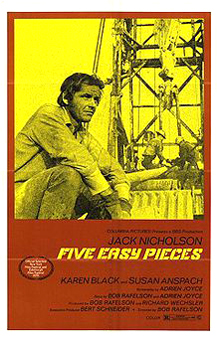
The enormous, game changing success of Easy Rider led to a multi-picture deal with Columbia. Now able to launch personal projects with less studio pressure, the company BBS was officially underway. Bob Rafelson's Five Easy Pieces pleased virtually everybody, public and critics alike. Nicholson became a full-fledged star as Bobby Dupea, a soul-sick son of a musically blessed family who wanders between jobs in oil fields. He feels stifled in his relationship with Rayette Dipesto, a waitress and Tammy Wynette fan almost too clueless to be endearing. "Lost in America" in a way totally different from the outlaws of Easy Rider, Dupea hasn't got what it takes to resolve his family or personal problems, and elects to just stay on the run. To its credit, the impressive Five Easy Pieces brings a European style and attitude to American filmmaking, without the more obvious pretensions of continental art movies. Laszlo Kovacs' visuals of an "on the road" America seem entirely fresh. Firmly rooted in character (as opposed to trumpeting auteurish director moves), the show is a genuinely touching portrait of an involuntary heel. Perhaps the simplest way to distinguish BBS films is to remark on their essentially European sensibility. A good point of comparison might be Paul Mazursky's Bob & Carol & Ted & Alice. An interesting picture, it still resembles a standard Hollywood sex farce. 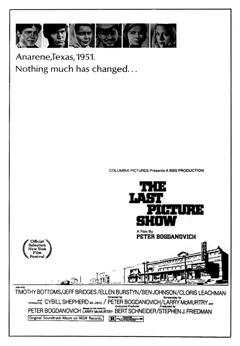
Nominated for four Oscars, Five Easy Pieces put BBS at the forefront of "independent" Hollywood filmmaking. Corman/A.I.P. graduate Peter Bogdanovich got the nod to adapt an ambitious Larry McMurtry novel, a soap opera about sex in a Texas town circa 1950. Bogdanovich saw his show as an opportunity to reinvent the classic cinema of his idols John Ford and Howard Hawks. He filmed in B&W (a really tough sell in 1971) and cast a few veteran character actors against a number of relative unknowns. The Last Picture Show hit the proverbial home run. It opened the first Los Angeles Film Exposition (FILMEX) and became the picture to see. The crowds came to check out Cybill Shepherd's diving-board strip at a skinny-dip swimming party, and left impressed by Ben Johnson's Sam the Lion, the town's last survivor from a time when the economy wasn't a disaster and the area had a future. The script has a wide-open but realistic attitude toward all the sordid sexual antics afoot. It tries for muted tragedy and doesn't quite make it; the expected futile ending seemed built-in to the BBS view of the times. (Note: the version of Last Picture Show on the disc is Bogdanovich's longer director's cut. He reportedly added scenes but excised some of the male nudity.) Thus BBS helped launch Peter Bogdanovich on a multi-film winning streak. The company produced more good pictures but didn't continue to expand its range, except politically. The trade papers were waiting to pounce when any "youth" film by studio outsiders flopped. From 1972 onward almost all of them did, including Dennis Hopper's subsequent picture for Universal, The Last Movie. America's bread and butter remained pictures like Dirty Harry and The Poseidon Adventure. What's more, only later would we find out that the star directors of the films had relied heavily on assists from unpublicized collaborators, like writer Carole Eastman ("Adrien Joyce") and the "costume designer" Polly Platt, who performed major producing duties on Last Picture Show. The true history of the period wouldn't be written for some time. I came to UCLA and its film school in 1970, and the first film that professor Louis Clyde Stoumen told us to go see was Five Easy Pieces at the Four Star Theater on Wilshire Blvd. They also showed a short subject, a film called Amblin' by a fellow named Steven Spielberg! UCLA enjoyed a good relationship with BBS. Peter Bogdanovich generously brought all of his pictures to us for screenings, and the others received evening screenings. Drive, He Said was Jack Nicholson's directorial debut (not counting his retakes for Roger Corman's The Terror almost ten years before). Its two leading actors are by turns unimpressive or annoying -- leaving supporting player Robert Towne to come off rather well. 
The story is a serious campus saga that unfortunately shapes up as an unfunny version of Richard Rush's awkward comedy Getting Straight. William Tepper's basketball star has difficulty taking anything seriously, including his future as a pro player. It is clear that a major effort of serious hoops fan Nicholson went into the basketball scenes, which are very convincing. Michael Margotta plays the campus radical / draft evader as if the part were a gonzo acting lab experiment. He's a bundle of inconsistent drug-fueled attitudes that would prevent him from being the leader of anything. Karen Black is interesting but undeveloped as a faculty wife sleeping with the basketball star. And that's basically it. Nicholson makes a big deal of male nudity and locker room humor. In a ponderous, symbolic finale Margotta frees the animals in the biology lab -- it's a big fizzle. Timing may have been part of the problem. 1970's lame campus rebellion sagas had already exhausted the audience's patience with the subject. One can't watch The Strawberry Statement today without cringing. That brings us to 1971's A Safe Place. Stage director Henry Jaglom was a personal friend of one of the BBS founders and a significant contributor to Raybert's success; it's said that he was responsible for knocking Dennis Hopper's multi-hour cut of Easy Rider down to screenable length. BBS gave Jaglom a directing shot with this experimental feature that consists mostly of actors emoting to camera on rooftops. Monologues, dream characters and endless minutes of Orson Welles staring meaningfully (or performing magic tricks) make the show seem to last an eternity. I've read praise about the movie but have to say that it was sheer death to sit through, even in the perfect prints that seemed to screen all too often in UCLA's Melnitz Hall. And we like Orson Welles and love Tuesday Weld. The clerk at RBC once said he couldn't remember anyone ever asking to rent or borrow a non-theatrical print. This Lost and Found Blu-ray of A Safe Place is the first time it's been released on home video. With all due respect to the prolific Jaglom's later writing and directing career, the picture is just plain deadly. 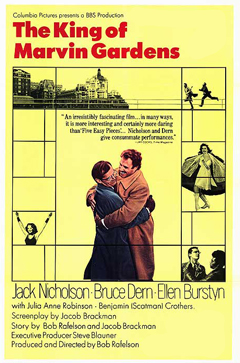
The King of Marvin Gardens is a fine drama that shows what Bob Rafelson could make of a small budget and some great actors. This time Nicholson plays a quiet type, an unassuming and introverted radio personality. David finds himself pulled into the wild real estate development schemes of his brother Jason (a fantastic performance by Bruce Dern). It all takes place in Atlantic City before it became a gambling Mecca. Jason lives in a dream world where the fantastic deal of a lifetime is only a few days away; he suffers from an aggravated inability to deal with the truth. Every ounce of his energy goes into selling his delusions to others. Jason's two live-in girlfriends (Ellen Burstyn and Julia Anne Robinson) are convinced that he owns one of the run-down hotels on the boardwalk. His newest fantasy is that he's an inch away from closing a scheme to build a giant resort on a tiny uninhabited Hawaiian island (???). Although even the casual investors that David and Jason contact seem uninterested, Jason goes ballistic whenever David threatens Jason's bubble of positive thinking. In reality, Jason's only support comes from a local hoodlum, Lewis (Scatman Crothers), who humors him out of pure pity. Jason tries to pull David into his delirium with promises of sharing the two women, but Sally and Jessica turn out to have ideas of their own. Comprised of little more than three or four actors talking on the beach or inside various mildewed hotel rooms, Rafelson's superior The King of Marvin Gardens is nevertheless an absorbing drama, another BBS downer about unhappy people dealing with All-American self-delusion, in this case, the Get Rich Quick syndrome. It did very well considering its lack of commericial hooks. Nicholson makes a fine straight man for Bruce Dern, who carries the movie on sheer energy. It's probably Dern's best film. By 1974 things had quieted down at BBS. When Columbia backed out of their distribution deal, Bert Schneider's inflammatory Vietnam documentary Hearts and Minds was off-loaded to Warners. The last I saw of BBS was when Rafelson was screening cuts of his United Artists film Stay Hungry upstairs in the building's beautiful projection room. Criterion's Blu-ray of America Lost and Found the BBS Story presents all seven films in beautiful HD transfers. The Criterion credits do not have the usual transfer and clean-up information, so I'm guessing that Sony's Grover Crisp provided finalized encodings of the pictures. All of them are clean and bright. The Last Picture Show is much improved over old flat TV prints, and the colors on Five Easy Pieces are back to the way the film looked 40 years ago -- rich and dark. The late Laszlo Kovacs supervised the transfers of the films he shot, which indicates how long this project has been aborning. Judging by the way the extras are described, a number of producer Greg Carson's interviews and featurettes are retained from Sony's abandoned release, before Criterion stepped in. Many of the principal players participate, with Bob Rafelson and Jack Nicholson offering candid observations and amusing anecdotes. A partial list of extras: Head includes a docu on BBS, screen tests and a 1968 TV interview with the Monkees: Easy Rider has two commentaries and extras from older Sony disc releases, as well as a new interview with Steve Blauner; Five Easy Pieces comes with another star-laden docu about BBS and a Rafelson commentary; The Last Picture Show also has two commentaries old and new, and two documentaries, including the entire 1990 Hickenlooper Picture This docu (41 min.), and an interview with François Truffaut. Drive, He Said and A Safe Place each carry a dedicated docu, while The King of Marvin Gardens is dominated by two Bob Rafelson interview featurettes and a scene-specific commentary. The six Blu-ray discs come in card and plastic folders within a card slipcase with a theater marquee design motif. Drive, He Said and A Safe Place share a disc. A 112-page book contains essays on five of the films by Chuck Stephens, Matt Zoller Seitz, Kent Jones, Graham Fuller and Mark Le Fanu, with J. Hoberman contributing an engrossing extended essay on the full history of the BBS Company. America Lost and Found the BBS Story is an atypical Criterion product in that it adapts an unreleased special edition from a major studio. With the studio Home Video divisions now diverting their deep library titles to new Burn On Demand programs, these are excellent days for the Criterion Collection.
On a scale of Excellent, Good, Fair, and Poor,
Reviews on the Savant main site have additional credits information and are often updated and annotated with reader input and graphics. Also, don't forget the 2010 Savant Wish List. T'was Ever Thus.
Review Staff | About DVD Talk | Newsletter Subscribe | Join DVD Talk Forum |
| ||||||||||||||||||